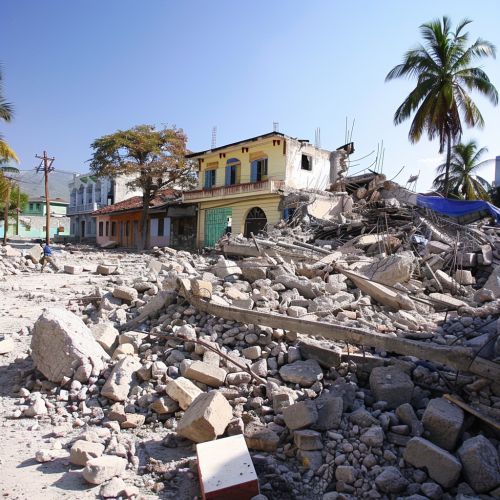2010 Haiti earthquake
Overview
The 2010 Haiti earthquake was a catastrophic magnitude 7.0 Mw earthquake, with an epicenter near the town of Léogâne, approximately 25 kilometers (16 miles) west of Port-au-Prince, Haiti's capital. The earthquake occurred at 16:53 local time (21:53 UTC) on Tuesday, 12 January 2010. By 24 January, at least 52 aftershocks measuring 4.5 or greater had been recorded. An estimated three million people were affected by the quake. Death toll estimates range from 100,000 to about 316,000, making it one of the deadliest natural disasters in recorded history.


Geological Background
The island of Hispaniola, which Haiti shares with the Dominican Republic, lies atop the boundary between the Caribbean Plate and the North American Plate. This tectonic setting is characterized by complex interactions, including strike-slip faulting and subduction. The Enriquillo-Plantain Garden fault zone is a major fault line running through Haiti, and it was the primary source of the 2010 earthquake. This fault is a left-lateral strike-slip fault, meaning that the two sides of the fault move horizontally past each other.
Seismic Event
The earthquake's epicenter was located near Léogâne, and the hypocenter was at a depth of 13 kilometers (8.1 miles). The earthquake's rupture propagated along the Enriquillo-Plantain Garden fault zone, releasing a significant amount of energy. The shaking lasted for approximately 35 seconds, causing widespread destruction.
Aftershocks
Following the main event, numerous aftershocks were recorded, the largest of which was a magnitude 5.9 Mw event on 20 January 2010. These aftershocks contributed to the ongoing destruction and hampered rescue and recovery efforts.
Impact
The earthquake caused massive damage to infrastructure, including homes, commercial buildings, and critical facilities such as hospitals and schools. The Palace of Justice, the National Assembly, and the Port-au-Prince Cathedral were among the notable structures that were heavily damaged or destroyed.
Humanitarian Crisis
The earthquake resulted in a significant humanitarian crisis. Approximately 1.5 million people were displaced, and many were forced to live in makeshift camps with inadequate sanitation and medical care. The lack of clean water and proper sanitation facilities led to outbreaks of diseases such as cholera.
Casualties
The death toll from the earthquake is estimated to be between 100,000 and 316,000 people. The wide range in estimates is due to the chaotic nature of the disaster and the challenges in accurately counting the dead.
Response and Relief Efforts
The international community responded quickly to the disaster, with numerous countries and organizations providing aid. The United Nations and various non-governmental organizations (NGOs) played a significant role in coordinating relief efforts. The United States, Canada, and the European Union were among the largest contributors of aid.
Challenges
The response efforts faced numerous challenges, including damaged infrastructure, logistical difficulties, and security concerns. The destruction of the main port and the airport in Port-au-Prince further complicated the delivery of aid.
Long-term Recovery
Rebuilding efforts have been ongoing since the earthquake, with a focus on improving infrastructure, healthcare, and education. However, progress has been slow, and many Haitians continue to live in precarious conditions.
Economic Impact
The earthquake had a devastating impact on Haiti's economy, which was already one of the poorest in the Western Hemisphere. The total economic damage is estimated to be between $7.8 billion and $8.5 billion, which is equivalent to approximately 120% of Haiti's GDP at the time. The destruction of businesses, homes, and critical infrastructure severely hampered economic activity.
Environmental Impact
The earthquake also had significant environmental consequences. The destruction of buildings and infrastructure led to large amounts of debris and waste, which posed challenges for disposal and recycling. Additionally, the displacement of people into makeshift camps put pressure on local ecosystems and resources.
